Oil lamp
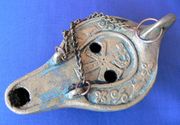
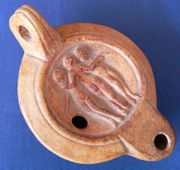
An oil lamp is a simple vessel used to produce light continuously for a period of time from a fuel source. The history of oil lamps extends for about 10,000 years, from prehistory to as late as the 19th century, or even until now in some rural remote communities.
Olive oil lamps continued in wide use in countries around the Mediterranean Sea well into the 19th century, with the lamps being mass produced out of metal (most commonly brass or bronze), but otherwise little changed in design from lamps of some 2,000 years earlier. In 1780 the Argand lamp was invented and quickly replaced the ancient form. It was, in turn, replaced by the kerosene lamp in about 1850. In small towns and rural areas these continued in use well into the 20th century. The light given by an olive oil lamp is significantly brighter than a candle, but significantly less than the Argand lamp or the kerosene or paraffin burning lamp.
Structure & Function
Oil lamps were used not only for lighting, but also for funerary and votive purposes. Lamps were used for domestic purposes in homes and for public purposes in temples and public buildings.
By studying the lamp's designs, symbols, structure and decorations, and the material of which it is made, we can identify the age and perhaps the locality of the lamp. The lamp can also give us insights into the culture of its users and their social status.
Occasionally the design of the lamps also reveal feminine reproductory system. Indian bronze lamps with a protruding central portion is supposed to project the masculine genital on a feminine womb with light representing 'origin of life' in most cases.
Oil lamps were made from a wide variety of media like gold, bronze, silver, stone and terra-cota. The most commonly used material was fired clay; terra-cotta and many bronze lamps have been unearthed. In most cases, the production and distribution of lamps was local, but in some instances they were produced by factories and exported to different areas..
The usual size of a terra-cotta oil lamp is 7-10 cm in length and 3 cm in depth. The walls being around 0.5 cm thick. Lamps with more than one nozzle are usually larger in size.
Components
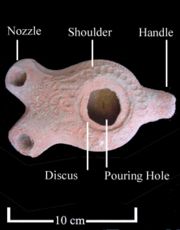
The following are the main external parts of a terra-cotta lamp.
- Shoulder
- Pouring hole
- The hole through which fuel is put inside the fuel chamber. Its width ranges from 0.5 -5 cm in general There may be single or multiple holes.
- Wick hole, and the nozzle.
- It may be just an opening in the body of the amp, or an elongated nozzle. In some specific types of lamps there is a groove on the superior aspect of the nozzle that runs to the pouring hole to collect back the oozing oil from the wick.
- Handle
- Lamps come with and without a handle. The handle comes in different shapes. The most common is ring shaped for the forefinger surmounted by a palmette on which the thumb in pressed to stabilize the lamp. Other handles are crescent shaped, triangular and semi-oval. The handleless lamps usually have an elongated nozzle, and sometimes have a lug rising diagonally from the periphery. The lug may act as a small handle where the thumb rests. Some lugs are pierced. It was speculated that pierced lugs were used to place a pen or straw, called the acus or festuca, with which the wick was trimmed. Others think that the pierced lugs were used to hang the lamp with a metal hook when not in use.
Wicks
A wick is placed over the pennis and extends into the fuel chamber. Most lamps come with one nozzle, few lamps had more, from two to twenty nozzles. However, the more the nozzles, the more the consumption of fuel.
The wick was made of different materials, linen, flax, papyrus, tow, or ordinary rush. The Thickness of the wick is an important factor too, thin wick burn fuel slower than thick ones. However, the thickness of the wick does not affect the size of the flame much.
Fuel
The main fuel was olive oil, though extracts from fish, crude fish oil, nuts, and plants were also used. Oozing crude petroleum was also used. The fuel was poured into the fuel reservoir via the pouring hole in the discus.
Lamp Holders
Lamps were put on lamp holders when in use. Lamp holders include:
- They were fastened to a wall by a nail or a wooden wedge. *They were also hung suspended from brackets
- They where placed in candelabra.
- Sometimes they were placed in niches in the wall.
- They were put on lamp stands of different shapes.
Production Methods
Hand Made
Before the discovery of the wheel, lamps were handmade.
Wheels
The crude potter’s wheel was introduced in the Middle Bronze age and lamps were thus made until the 3rd c. BC. In the Hellenistic period increasingly lamps were mould made.
Lamp Moulds
The use of molds was first developed in Greece and Egypt during the 3rd century BC. In the Roman times, the molds were regularly used in large scale in the different parts of the Roman Empire. The use of molds continued up to the 8th century AC. Molds can be stone, clay, or plaster.
Plaster vs. Clay Moulds
An archetype or patrix was first made. Plaster or clay was then formed around the patrix, it will then dry and harden into a mold.
Clay moulds, were removed from the patrix before they had fully dried. Then they were kiln fired, thus they may deviate or shrink from their original form. Clay molds needed more labour than plaster ones. These problems are not encountered with plaster. Plaster molds were dried completelty then removed from the patrix. Paaslter thius makes an accurate replica, but it has the disadvantage of leaving some surface granular artifacts. However, clay molds are more durable.
It is difficult to find the remains of ancient plaster molds as it is a perishable material. Some clay moulds were recovered. By studying the surfaces of surviving lamps it seems that plaster was preferred to clay.To make a lamp, two molds are needed one for the upper art and one for the lower part. Some pairs of molds have knobs and corresponding holes to fit the two molds together.
Lamp Typology
Lamps can be categorised based on different criteria as follows below:
Lamp Typological Categories
Typologically, ancient lamps can be divided into six major categories
- Wheel Made
Greek and Egyptian lamps that date before the 3rd century BC. Simple, little or no decoration, wide pour hole. No handles. A lug. Pirced or not. Pierced lugs occuried beifly between 4th and 3rd century BC. Unpierced lugs continued until 1st century BC.
- Volute, Early Imperial
With volutes extending from their nozzles, predominately produced in Italy during the Early Roman period. They have a wide discus, a narrow shoulder and no handle. Elaborate imagery and artistic finishing and wide range of patterns of decoration.
- High Emperial
These are late Roman. . the shoulder is wider and the discus is smaller with less decorations. Have handles and short plain nozzles. Lesser artistic finishing.
- Frog
This is a regional style lamp exclusively produced in Egypt and found in the regions around it too, between ca. 100 – 300 AD. the frogs are an Egyptian fertility symbol.
- African Red slip
indigenous to North Africa and decorated in a red slip. Second century AD. wide variety of shapes. A flat heavily decorated shoulder with a small and relatively shallow discus. Their decoration is either neutral, Christian or Jewish. Grooves run from the nozzle back to the pouring hole, may be to take back slipping oil. Often have more than one pour-hole.
- Slipper
Oval shaped. Found mainly I the leant. Produced between 3rd to 9th centry AC. Decorations include vine scrolls, palm wreaths, and Greek letters.
- Factory Lamps
also called Firmalampen, these are universal in distribution, and simple in appearance. They have a channeled nozzle, plain discus, and 2 or 3 depressions on the base with matching protrusions or bumps on the shoulder. These convex and concave elements function like modern day Lego, allowing the lamps to be securely stacked one on top of another.
Initially made in factories in Northern Italy and Southern Gaul between 1st century and 3rd centuries AD. They were exported to all Roman provinces. The vast majority have been stamped to identify the manufacturer.
Oil Lamps in Religion
The Bible
- And you shall command the people of Israel that they bring to you pure beaten olive-oil for the light, that a lamp may be set to burn continually. Exodus 27:
- When you set the lamps, the seven lamps shall give light in front of the lamp stand (menorah).Numbers 8: 1 -4
- There I shall cause pride to sprout for David; I have prepared a lamp for my anointed.� (Psalms 132:16);
- For a commandment is a lamp and the Bible is light; and reproving discipline is the way of life. (Proverbs 6:23);
- A mans soul is the lamp of God, which searches the chambers of ones innards. (Proverbs 20:27).
- A lamp is called a lamp, and the soul of man is called a lamp. (Babylonian Talmud, Shabbat 30B)
- Your eye is the lamp of your body; when your eye is sound, your whole body is sound, your whole body is full of light; but when it is not sound, your body is full of darkness. (Luke 11:34);
- He was a burning and shining lamp, and you were willing to rejoice for a while in his light. (John 5:35);
- And night shall be no more; they need no light of lamp or sun, for the Lord God will be their light, and they shall reign for ever and ever.” (Rev. 22:5).
Lamps appear in the Bible as a way for the righte, the wise, and for love and other positive values.While fire was described in the bible as being destructive, light was given a spiritual positive meaning. The oil lamd and its light was an important item of the household in biblical times, this may explain their use and connotations in the bible.
Oil lamps were used for many spiritual rituals. They were buried with the dead to comfort the sole and to light the way to the hereafter. They lit the interior of dark tombs. Lamps were used to honour the memory of the deceased as well as acting against evil spirits. The oil -lamp and its light also became an important ritualistic article with the further development of Jewish culture and its religion.
The Quran
"God is the Light of the heavens and the earth. The parable of His light is, as it were, that of a niche containing a lamp; the lamp is [enclosed] in glass, the glass [shining] like a radiant star:[a lamp] lit from a blessed tree - an olive-tree that is neither of the east nor of the west the oil whereof [is so bright that it] would well-nigh give light [of itself] even though fire had not touched it: light upon light! God guides unto His light him that wills [to be guided]; and [to this end] God propounds parables unto men, since God [alone] has full knowledge of all things". 24:35
Archaeological Chronology
It is very difficult to say when and where was the first oil lamp used. This is partly because it is difficult to draw a the line when the primitive forms of creating a continuous source of light from fire can be termed a lamp. The first lamps were made of naturally occurring objects, coconuts, sea shells , egg shells and hollow stones.Some believe that the first proper lamps were carved from stones. Curved stone lamps were found in places dated to the 10th century BC. (Mesolithic, Middle Stone Age Period, circa 10,300 - 8000 BCE)
Some Archaeologists claim that the first shell-lamps were in existence more than 6,000 years ago. (Neolithic, Later Stone Age, c. 8500 - 4500 BCE). They believe that the alabaster shell -shaped lamps dug up in Sumerian sites dating 2,600 BCE were imitations of real shell -lamps that were used for long ties. (Early Bronze, Canaanite / Bronze I-IV, c.3300 - 2000 BCE)
It is generally agreed that the evolution of hand made lamps moved from bowl-shaped to saucer-shaped, then from saucer with a nozzle to a closed bowl with spout
Chalcolithic Age,c.4500 - 3300 BCE.
Appeared the first manufactured red pottery oil lamps, these were of the round bowl-type.
The Bronze Ages (3200-1200 BCE)
lamps are simple wheel made bowls, with a slight pinch on four sides for the wick. Lamps later have only one pinch. These lamps vary in the shape of the rim, the general shape of the bowl and the shape of the base.
Intermediate Bronze Age lamps (EBIV/MBI) The earliest lamps known from Intermediate Bronze Age lamps (EBIV/MBI) With the four wick lamps. These lamps are made from large bowls with four shallow pinches for wicks.
- Middle Bronze Age lamps (MB) –the four wick oil lamps persist into this period, most of the lamps now have one wick. Early in this period the pinch is shallow, while later on it becomes more prominent and the mouth protrudes from the lamps body. The bases are simple flat. The crude potter’s wheel is introduced, transforming the hand made bowls to a more uniform container. The saucer style evolutes into a single spout shape.
- Late Bronze Age lamps (LB) – The A more pronounced single deeper spout is developed, it is almost closed on the sides. The shape evolving into more triangular deeper and larger. All lamps are now wheel made. The base is simple, usually flat.
The Iron Age (1200-560 BCE)
The rim becomes wider and flatter with a deep and higher spout. The tip of the spout is more upright in contrast to the rest of the rim.
The lamps are becoming variant in shape and distribution. We still find lamps similar to the Late Bronze period. In addition, other forms evolve. . Small ones with a flat base and larger ones with a round base. The later form continues into the Iron Age II.
In later Iron Age, we encounter variant forms. One common type is small, with a wide rim and a wide base. Another type is small, shallow bowl with a thick and high discus base.
Persian
These large lamps have thin sides and a deep pinch, which flattens the mouth and makes it protrude outward
Greek
Lamps are more closed to avoid spilling. They are smaller and more refined. Most are handleless. Some are with lug, pirced and not pirced. The nozzle is elongated. The rim is folded over to make the nozzle, so it overlaps and is then pinched to make the wick hole.
They are round in shape, wheel-made.
Early Roman
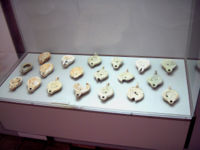
Production of oil-lamps shifted to Italy as the main source of supply . Molds used. All lamps are closed in type. Lamps produced in large scale in factories. The lamp is produced in two parts, the upper port with the spout and the lower part with the fuel chamber. Most are of the characteristic Imperial Type. It was round with nozzles of different forms (volute, semi-volute, U shaped), with a closed body and with a central disk decorated with reliefs and its filling hole.
Late Roman
The High Imperial Type. More decorations. Produced locally or imported in large scale. The multiple nuzzled lamps appear. Different varieties.
In this period we find the frog type laps. These are kidney or heart shaped or oval. With the motive of a fron or ts abstraction, and some times with geometrical motives. They were produced around 100 AC. They are so variant that it is seldom to find two identical ones.
Early Islamic
There is a transition period from Byzantine to Islamic lamps. Lamps of this transition period changed from being decorated with the cross, animals, human likenesses, birds, fish, etc., to being decorated with plain, linear, geometric, raised dot patterns.
The early Islamic lamps are a continuation of Byzantine lamps. Decorations were initially a stylized form of bird, grain, tree, plant or flower, then they became entirely geometric or linear with raised dots.
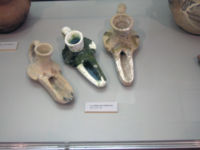
In the transion period some lamps had some Arabic writing. Then, writing disappears until Mamluk period (13 - 15 C.E.).
The Early Muslim lamps show a decline in the quality crafsmanship of lamps. Lamps are heavier, more coarse and generally poorly baked.
Regional Variations
Israel/Palestine
- Jerusalem oil lamp: Charateristically black color of the clay. Because of clay being burned without oxygen. Usually of high quality.
- Herodian oil lamp: considered to be used mainly by Jews. Wheel made, rounded. Nozzle with concave sides. The lamps are usually not decorated. If there is decoration, it tends to be simple. Very common throughout all of Israel, Some lamps were also found in Jordan. Date from 1st century. BCE to the end of the 1st cent AC.
- Menorah oil lamp, 7 nozzles: are rare and associated with Judaism because of the numerical connection with the seven branches or arms of the Menorah.
- Samarian oil lamp: Characterised by a seal filling-hole marked by a ridge. A wider spout, and the concavities flanking the nozzle are almost always emphasized with a ladder pattern band. In general the lamps are uncoated. The decorations are linear and or geometric.
-
- Type I: a distinct channel running from the pouring-hole to the nozzle, a small knob handle, a ladder pattern around the nozzle and shows no ornamentation on the bottom of the base.
-
- Type II: pear-shaped and elongated, lined-channel, which extends from the filling-hole to the nozzle, continued to be used through to the Early Moslem Period.
- Candle Stick oil lamp: Menorah design on the nozzle and bunch of grapes on the shoulders.
- Samaritan oil lamp: The upper parts are covered with braided patterns and their handles. All are made of a dark orange-red clay. A rounded bottom with a distinct x or cross appears inside the circled base
- Early
Islamic oil lamp: large knob handle and the channel above the nozzle are dominant
elements. The handle is tongue shaped. Decoration is rich and elegant. The lower
parts are extremely broad and the nozzles are pointed.
Books and Catalogues
General
- Bailey, D.M. (1975-96). A Catalogue of Lamps in the British Museum. British Museum. ISBN 0-7141-1243-7, ISBN 0-7141-1259-3, ISBN 0-7141-1278-X, ISBN 0-7141-2206-8.. Huge catalogue in four quarto volumes, THE lamp bible but extremely expensive even second-hand. Referred to as BMC.
- Walters, H.B. (1914). Catalogue of the Greek and Roman Lamps in the British Museum. British Museum. Superseded by Bailey but still worthwhile and much cheaper if you can find an old copy.
- Hayes, J.W. (1980.). Ancient Lamps in the Royal Ontario Museum - I: Greek and Roman Clay Lamps. ROM. ISBN 0-88854-253-4. Another superb catalogue and excellent reference, perhaps second only to Bailey.
- Djuric, Srdjan (1995). The Anawati Collection Catalog I - Ancient Lamps from the Mediterranean. Eika. ISBN 1-896463-02-9. Less academic than the museum catalogues and short on dating but fairly comprehensive (within its specified area, i.e. not Northern Europe) and extensively illustrated.
- Lyon-Caen; Hoff (1986). Catalogue des Lampes en terre cuite Grecques et Chretiennes. Louvre. ISBN 2-7118-2014-9. In French, good coverage of earlier and later lamps in the Louvre, well illustrated.
- Mlasowsky, Alexander (1993). Die antiken Tonlampen im Kestner-Museum Hannover. Kestner-Museum. ISBN 3-924029-13-X. In German, superb catalogue, profusely illustrated and captioned.
- Robins, F.W. (1970). The Story of the Lamp. Kingsmead. ISBN 0-901571-33-4. Useful introduction but illustrations are very poor and beware as several of the items shown have since been exposed as fakes.
- Bailey, D.M. (1972). Greek and Roman Pottery Lamps. British Museum. ISBN 0-7141-1237-2. Excellent introductory booklet, well illustrated.
- Wetzel, Henning (1997). Antike Tonlampen. Leipzig University. ISBN 3-931922-65-0. In German, small booklet but excellent illustrations in colour.
- Skinkel-Taupin, Claire (1980). Lampes en Terre Cuite de la Méditerranée Grecque et Romaine. In French, brief guide to a few lamps in the Brussels Museum.
- Clephan, R. Coltman (1907). On Terra-cotta Lamps. Edwardian illustrated article for the Society of Antiquaries of Scotland, interesting insight into the general knowledge of that time.
Western Europe
- Goethert, Karin (1997). Römische Lampen und Leuchter. Trier: Auswahlkatalog des Rheinischen Landesmuseums Trier. ISBN 3-923319-38-X. In German, emphasis on local lamps found in Trier but excellent coverage of all Roman types of the Rhineland.
- Eckardt, Hella (2002). Illuminating Roman Britain. Montagnac: Editions Monique Mergoil. ISBN 2-907303-70-8. Softback, frustratingly unindexed but a refreshing approach and well worth ploughing through.
- Loeschcke, Siegfried (1919). Lampen aus Vindonissa. In German, long out-of-print classic but a superb reference if you can find a copy.
- Kirsch, Annette (2002). Antike Lampen im Landesmuseum Mainz. ISBN 3-8053-2864-8. In German, catalogue of lamps.
- Chrzanovski, Laurent (2000). Lumieres Antiques: Les lampes à huile du musée romain de Nyon. Edizioni ET. ISBN 88-86752-15-6. Softback. In French with short summaries in English, Italian and German. Excellent general survey of lamps, detailed study and catalogue of the small collection of Roman oil lamps at Nyon.
Middle (Near) East
- Adler, Noam (2004). A comprehensive catalog of oil lamps of the Holy Land from the Adler collection. Israel: Old City Press. ISBN 965-555-166-0. Comprehensive coverage of lamps from Palestine region.
- Rosenthal, Renate; Sivan, Renée (1978). Qedem 8, Monographs of the Institute of Archaeology, Vol. 8: Ancient Lamps in the Schloessinger Collection. The Hebrew University of Jerusalem. Standard reference.
Aegean
- Broneer, Oscar (1977). Isthmia Volume III: Terracotta Lamps. American School at Athens. Good coverage of local lamps.
- Perlzweig, Judith (1963). Lamps from the Athenian Agora. American School at Athens. Excellent booklet, profusely illustrated and a recommended reference, very cheap used copies.
North Africa
- Herrman, J.L.; van der Hoek, A. (2002). Light from the Age of Augustine. Harvard. Softback, lavishly colour-illustrated guide to North African red slip ware including many lamps.
- Fabbricotti, E. (2001). Catalogo delle lucerne di Tolemaide (Cirenaica), BAR International Series 962. ISBN 1-84171-182-9. In Italian, detailed catalogue of locally found lamps
